Grinning Gargoyles and Grimacing Grotesques
Nov 22, 2010 19:32:22 GMT 10
brillbilly and Rareclan like this
Post by DigerDawg on Nov 22, 2010 19:32:22 GMT 10
We’ve all seen them, those odd looking carved faces, some with horns, some half animal or half human, often looking miserable, scowling at us from the outer walls of buildings. Often they’re spotted on churches and other older structures, but the practice of adding these ornamentations to more recently constructed buildings is quite common too. 
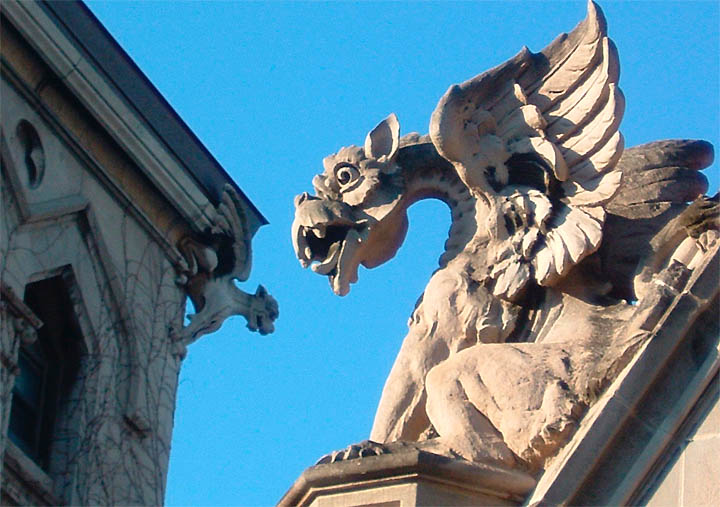
So where did these things first come from? One story about the origin of gargoyles comes to us from France. It was said that a massive dragon dwelled in a cave on the banks of the Seine, attacking ships on the river and also terrorizing the local population of the city of Rouen. The people made a sacrifice to the ferocious beast each year, calling it La Gargouille. However, at some point in the in the seventh century, Saint Romanus, in true knight in shining armour fashion, slew the dragon. The monster’s body was burnt on a massive fire, but the head, being accustomed to heat from the beast’s fiery breath, resisted the flames. So the people decided to keep it and mount it on the wall of a local church, as a warning to any other dragons who might be thinking of setting up camp near their city. And so the tradition of gargoyles began, or at least, according to this story.
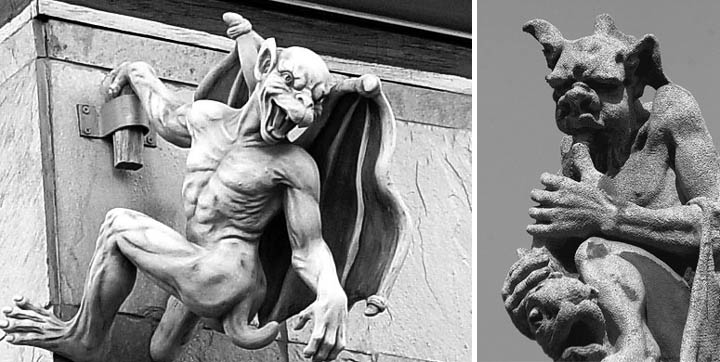
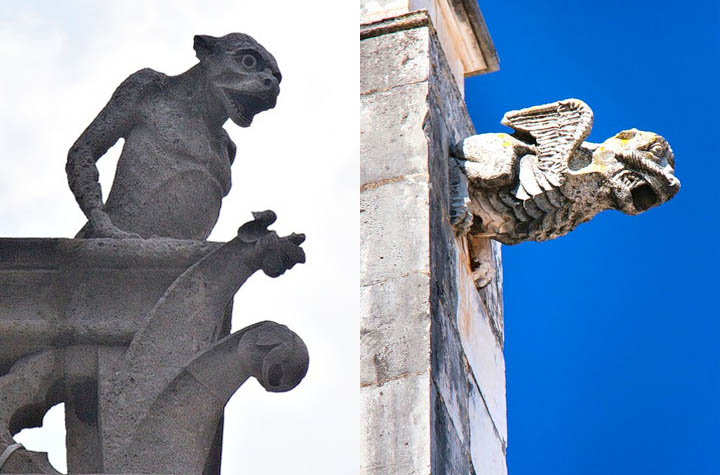
In reality, it would appear that gargoyles first started to appear between the eleventh and thirteenth centuries, their primary purpose simply being to divert rainwater. The carved figures have open mouths and long necks because they are really just decorative spouts, directing rainwater away from the building’s foundations. The word ‘gargoyle’ derives from the Latin word ‘gurgulio’, meaning ‘throat’ and also refers to the sound of liquid passing through the throat. This word has naturally also been adapted into other related Latin based languages such as French, Italian, Spanish and Portuguese. The Egyptians, Greeks, Romans and other ancient cultures all employed decorative waterspouts on buildings to some degree, often in the shape of a lion’s head, but the gargoyles we are most familiar with date from the Middle Ages.
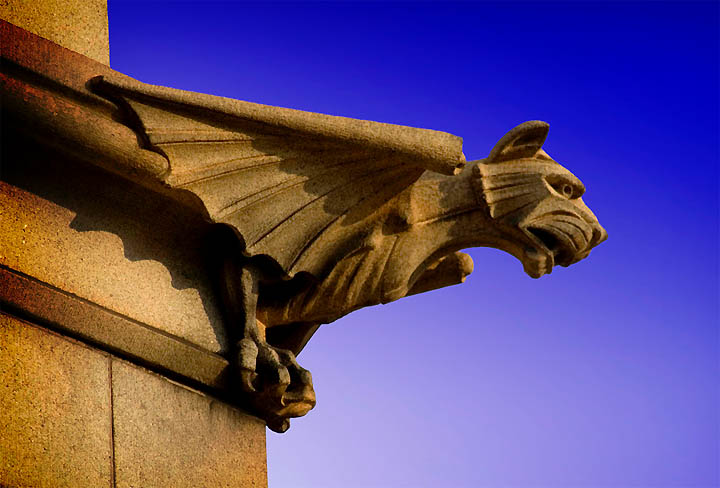
Gargoyles became a common sight in twelfth century Europe, especially on the outside walls of the continent’s great cathedrals. The stone carvings were usually quite scary depictions of people, animals, birds, mythological creatures, human/animal hybrids and so on, and very different to the statues or carvings of saints and other religious figures both inside and outside the same building. This was because as well as being simple drainage devices, gargoyles also served to remind the largely illiterate congregation of the nature of good and evil, plus encourage them to attend church. As was pointed out in the earlier articles here on Dark Roasted Blend entitled "Britain’s Colourful Pub Signs" Part One and Part Two, a visual reference was needed for the bulk of the population who couldn’t read.

The cathedral of Notre Dame in Paris is famous for the gargoyles adorning the exterior of the building:
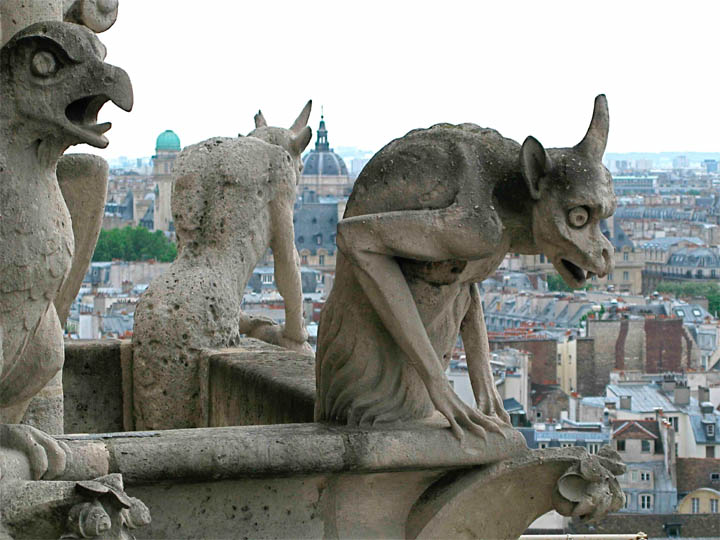
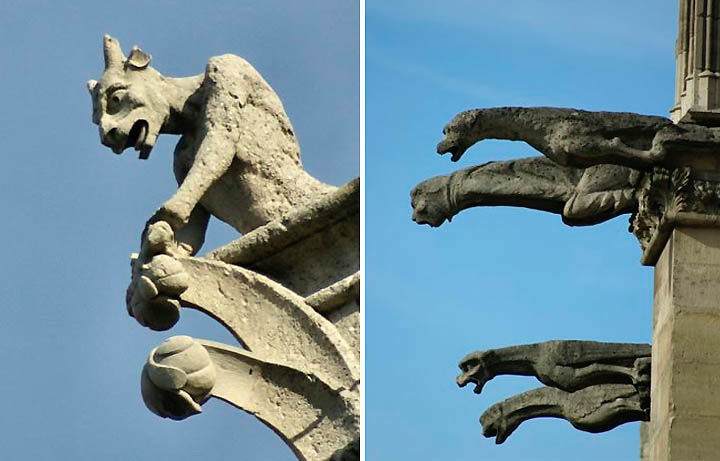

 Notre Dame's
Notre Dame's
first church was built by Childebert I, the king of the Franks in 528, and it was the Roman Catholic cathedral of the city of Paris in the 10th century.
The Church was demolished 1160 and the building of the church of today began in 1163 by Louis VII. It was more or less completed as a church in Gothic Style1345.
This pictures are mainly from the South Tower where the big bell Emmanuel is hanging. It weighs 13 metric tons; over 28,000 pounds.
I dont know yet the name of the artist that created this gargoyles - the artistic drain pipes- as monsters but I know that a restoration program was initiated in 1845, managed by architects Jean-Baptiste-Antoine Lassus and Eugène Viollet-le-Duc. Their task was to save and restore the church that was damage a lot during the French Revolution.
Also in Paris, here we see one of the gargoyles decorating the Basilica St Denis:
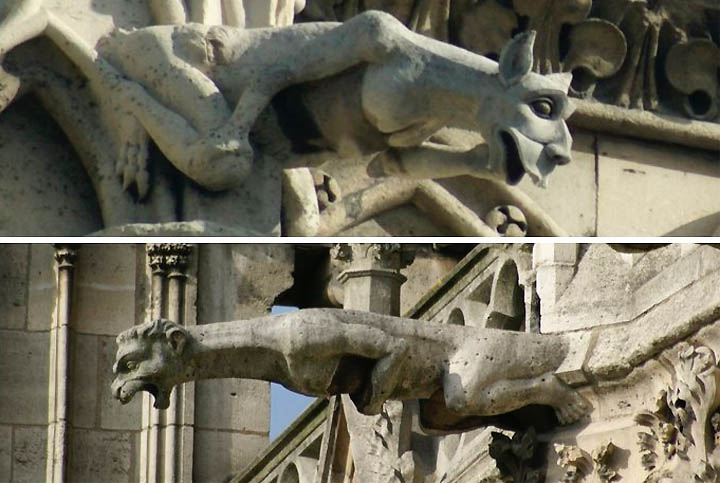
While this one on the Basilica of the Sacre Coeur shows a view of the water channel (plus various water spouts disguised as fish, or tongues):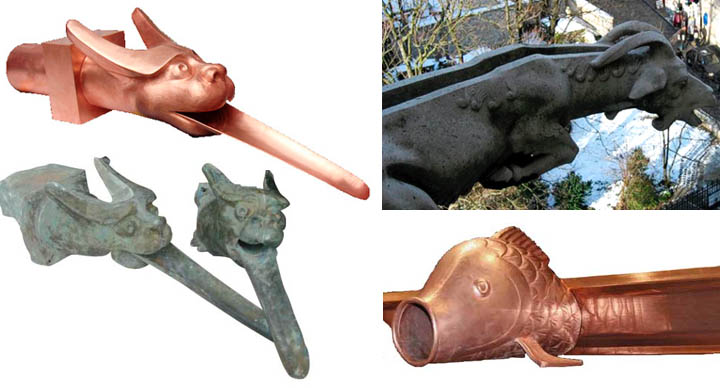
Various carved lions are guarding the Meaux Cathedral in France (left) and the Cathedral of Tarragona in Catalonia in northern Spain (right):
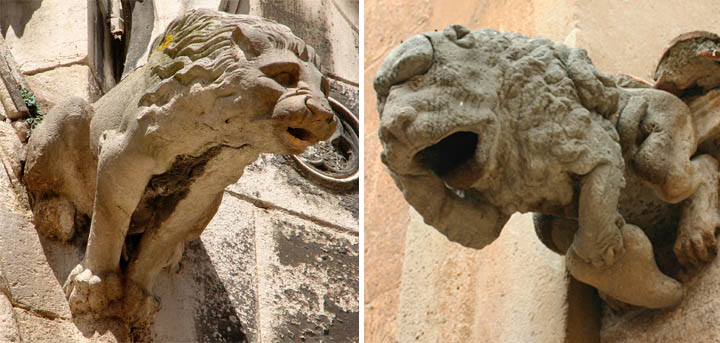
These fearsome looking creatures can be seen on the St.-Petrus-en-Pauluskerk in Ostend in Belgium (below left); while these dragon-inspired carvings decorate Ulm Cathedral in Germany (right):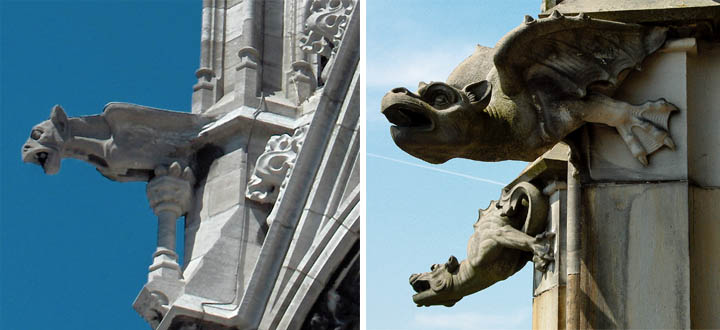
The United Kingdom has a large number of medieval religious structures. These gargoyles are from York Minster:
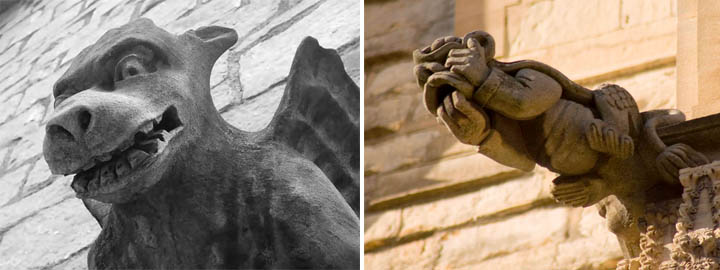
These are from Westminster Abbey in London:
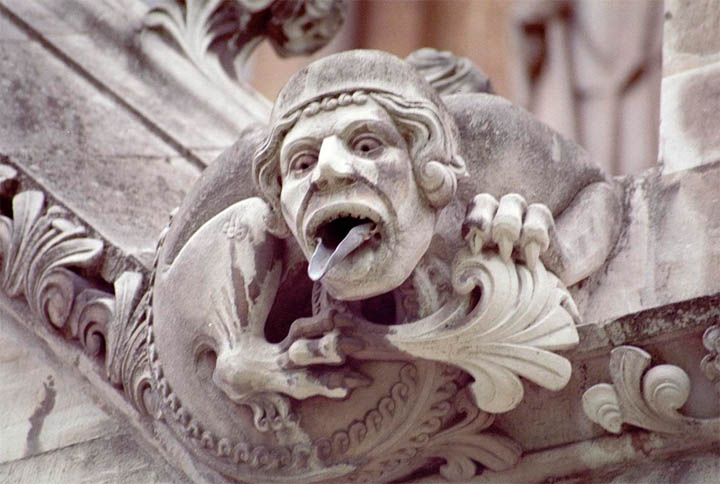
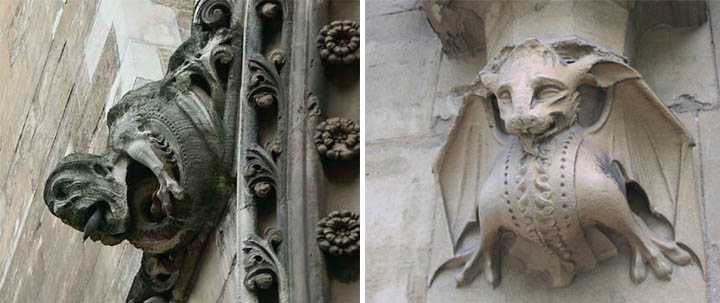
Gargoyles weren’t restricted to religious structures, as we can see from these examples decorating Windsor Castle (below left). The one below right is situated on the roof of Himeji Castle in Hyogo, Japan: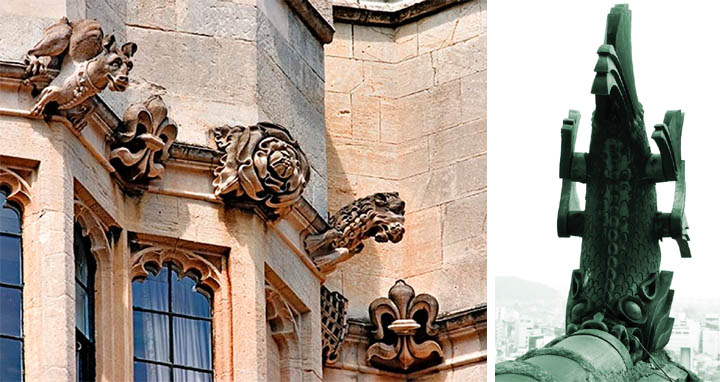

Gargoyles at the Concert Hall in Valencia, Spain (designed by the famous Santiago Calatrava):

The outer corners of the 61st floor of the Chrysler Building in New York feature these stainless steel eagles, replicas of the hood ornaments of 1929 Chrysler vehicles:
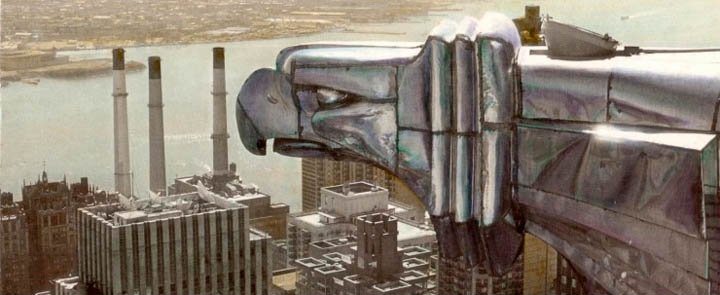
"Terror Behind the Walls" haunted prison tours are held at Eastern State Penitentiary (abandoned since 1971) - complete with some of the most frightening gargoyles we've ever seen
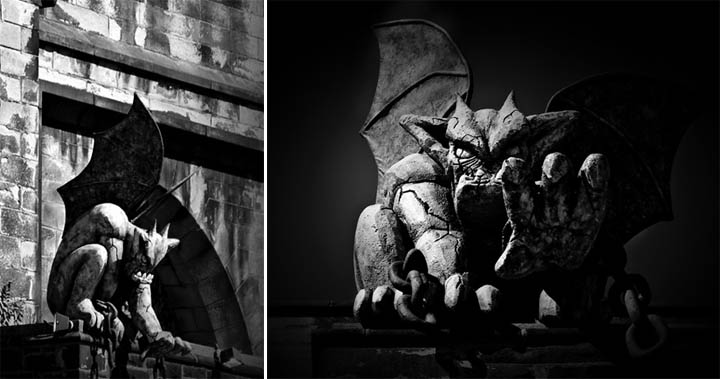
In Saratov, Russia, this howling gargoyle was spotted on the 1902 College-Conservatory of Music - probably making the most horrible sounds imaginable:
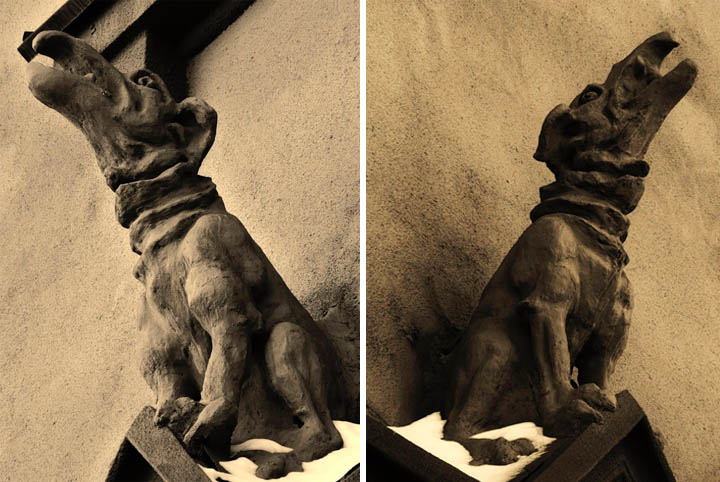
In South America, Quito Cathedral in Ecuador has a collection of gargoyles. In this case however, rather than the traditional figures we’re used to seeing, the Quito gargoyles depict the native animals of Ecuador and the Galapagos Islands:
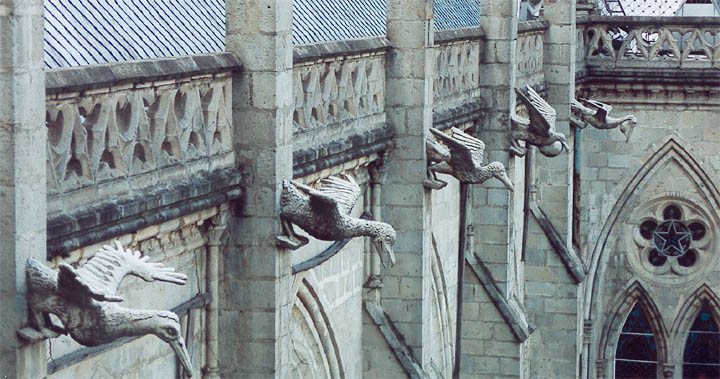
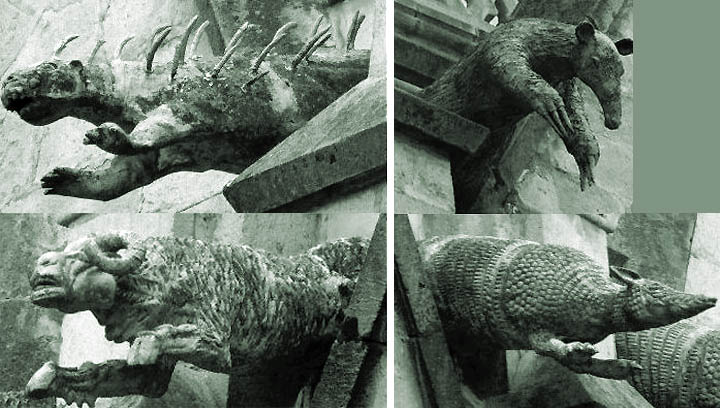
A common question is whether a carved figure is a gargoyle or is it a grotesque? Even if every gargoyle might indeed be grotesque, all grotesques are not gargoyles. As I mentioned earlier, if it serves as a drainpipe, it’s a gargoyle (here is one with a saber ice "teeth" making it even more fearsome - see here). A grotesque or chimera is a very similar figure on a building, but doesn’t have the purpose of leading water away from the structure as a drainage device. In North America, for example, buildings constructed in the late nineteenth and twentieth centuries often have decorations that everyone nonetheless refer to as gargoyles.
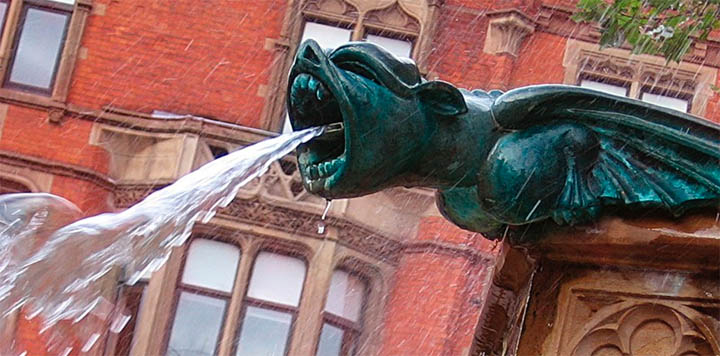
These walruses decorate the Arctic Club Building in Seattle (below left); Fire Department Headquarters in Philadelphia features these firemen gargoyles (below right):

Strange Alien-like figures can be seen on the Nativity of the Blessed Virgin Mary Chapel in Flagstaff, Arizona (below left). The "ruffled chicken creature" (below right) is from the University of Chicago:
Some weird character spotted on the Tours Cathedral, France (below left) - and a guy chewing his toenails, from Rufford Park, Nottingham, UK (below right):
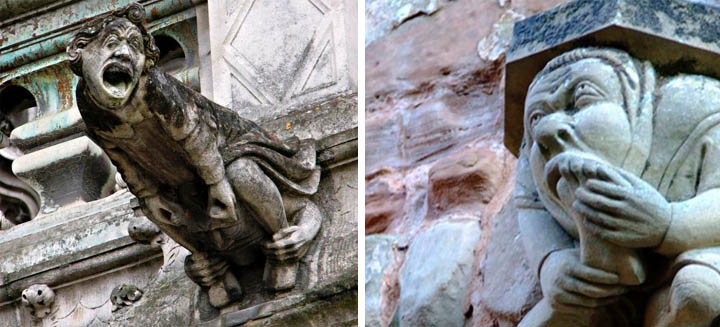
One on top of the other (Eglise Saint-Germain L’Auxerrois, Paris):
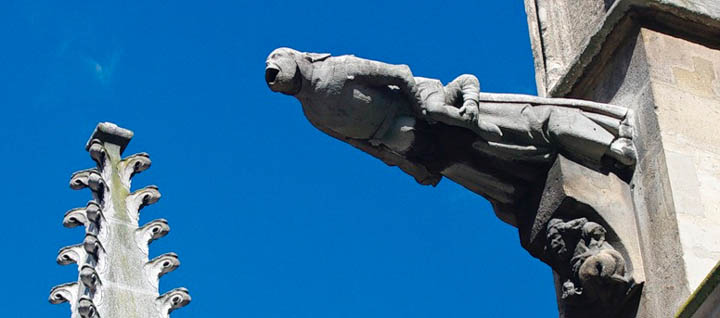
"The Scream": some gargoyles refuse to be silenced (Troyes, France) -
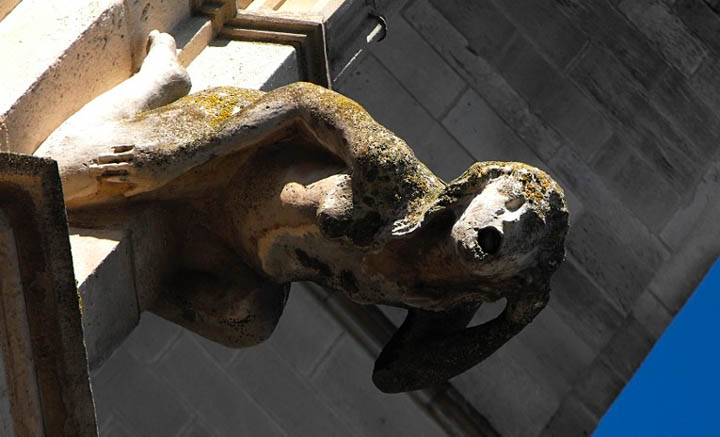
This guy is laughing and seems to be perpetually content (Gent, Belgium):

Listening to the wrong voice (below left):
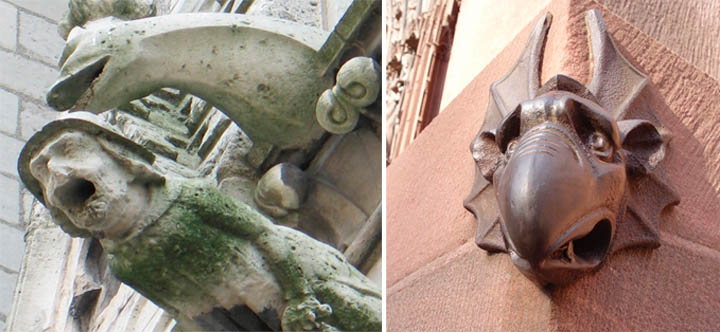
This interesting looking, humorous fellow can be seen on the outer wall of the tower of York Minster:

Indeed, even Darth Vader (the Face of the Evil Empire) adorns the Washington National Cathedral, Washington

Absolutely fantastic dragon, spotted in Copenhagen:
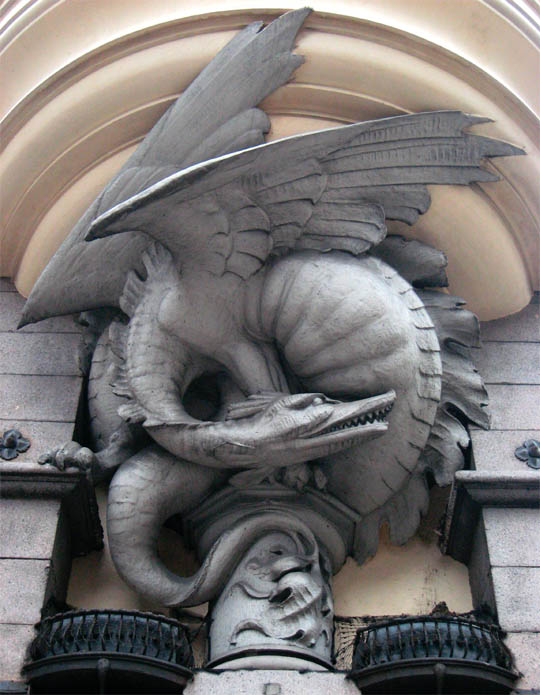
(Gargoyle jumping from the cathedral of Ulm -
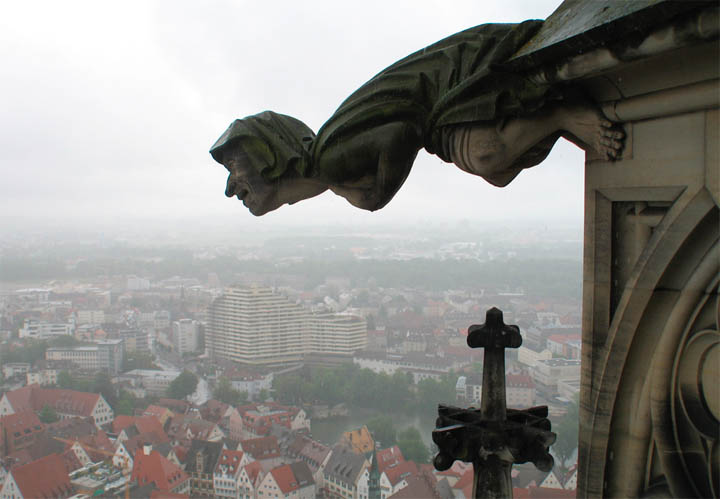
www.darkroastedblend.com/2010/09/gargoyles-grotesques-part-1.html
Dawg


So where did these things first come from? One story about the origin of gargoyles comes to us from France. It was said that a massive dragon dwelled in a cave on the banks of the Seine, attacking ships on the river and also terrorizing the local population of the city of Rouen. The people made a sacrifice to the ferocious beast each year, calling it La Gargouille. However, at some point in the in the seventh century, Saint Romanus, in true knight in shining armour fashion, slew the dragon. The monster’s body was burnt on a massive fire, but the head, being accustomed to heat from the beast’s fiery breath, resisted the flames. So the people decided to keep it and mount it on the wall of a local church, as a warning to any other dragons who might be thinking of setting up camp near their city. And so the tradition of gargoyles began, or at least, according to this story.


In reality, it would appear that gargoyles first started to appear between the eleventh and thirteenth centuries, their primary purpose simply being to divert rainwater. The carved figures have open mouths and long necks because they are really just decorative spouts, directing rainwater away from the building’s foundations. The word ‘gargoyle’ derives from the Latin word ‘gurgulio’, meaning ‘throat’ and also refers to the sound of liquid passing through the throat. This word has naturally also been adapted into other related Latin based languages such as French, Italian, Spanish and Portuguese. The Egyptians, Greeks, Romans and other ancient cultures all employed decorative waterspouts on buildings to some degree, often in the shape of a lion’s head, but the gargoyles we are most familiar with date from the Middle Ages.

Gargoyles became a common sight in twelfth century Europe, especially on the outside walls of the continent’s great cathedrals. The stone carvings were usually quite scary depictions of people, animals, birds, mythological creatures, human/animal hybrids and so on, and very different to the statues or carvings of saints and other religious figures both inside and outside the same building. This was because as well as being simple drainage devices, gargoyles also served to remind the largely illiterate congregation of the nature of good and evil, plus encourage them to attend church. As was pointed out in the earlier articles here on Dark Roasted Blend entitled "Britain’s Colourful Pub Signs" Part One and Part Two, a visual reference was needed for the bulk of the population who couldn’t read.

The cathedral of Notre Dame in Paris is famous for the gargoyles adorning the exterior of the building:



 Notre Dame's
Notre Dame'sfirst church was built by Childebert I, the king of the Franks in 528, and it was the Roman Catholic cathedral of the city of Paris in the 10th century.
The Church was demolished 1160 and the building of the church of today began in 1163 by Louis VII. It was more or less completed as a church in Gothic Style1345.
This pictures are mainly from the South Tower where the big bell Emmanuel is hanging. It weighs 13 metric tons; over 28,000 pounds.
I dont know yet the name of the artist that created this gargoyles - the artistic drain pipes- as monsters but I know that a restoration program was initiated in 1845, managed by architects Jean-Baptiste-Antoine Lassus and Eugène Viollet-le-Duc. Their task was to save and restore the church that was damage a lot during the French Revolution.
Also in Paris, here we see one of the gargoyles decorating the Basilica St Denis:

While this one on the Basilica of the Sacre Coeur shows a view of the water channel (plus various water spouts disguised as fish, or tongues):

Various carved lions are guarding the Meaux Cathedral in France (left) and the Cathedral of Tarragona in Catalonia in northern Spain (right):

These fearsome looking creatures can be seen on the St.-Petrus-en-Pauluskerk in Ostend in Belgium (below left); while these dragon-inspired carvings decorate Ulm Cathedral in Germany (right):

The United Kingdom has a large number of medieval religious structures. These gargoyles are from York Minster:

These are from Westminster Abbey in London:


Gargoyles weren’t restricted to religious structures, as we can see from these examples decorating Windsor Castle (below left). The one below right is situated on the roof of Himeji Castle in Hyogo, Japan:


Gargoyles at the Concert Hall in Valencia, Spain (designed by the famous Santiago Calatrava):

The outer corners of the 61st floor of the Chrysler Building in New York feature these stainless steel eagles, replicas of the hood ornaments of 1929 Chrysler vehicles:

"Terror Behind the Walls" haunted prison tours are held at Eastern State Penitentiary (abandoned since 1971) - complete with some of the most frightening gargoyles we've ever seen

In Saratov, Russia, this howling gargoyle was spotted on the 1902 College-Conservatory of Music - probably making the most horrible sounds imaginable:

In South America, Quito Cathedral in Ecuador has a collection of gargoyles. In this case however, rather than the traditional figures we’re used to seeing, the Quito gargoyles depict the native animals of Ecuador and the Galapagos Islands:


A common question is whether a carved figure is a gargoyle or is it a grotesque? Even if every gargoyle might indeed be grotesque, all grotesques are not gargoyles. As I mentioned earlier, if it serves as a drainpipe, it’s a gargoyle (here is one with a saber ice "teeth" making it even more fearsome - see here). A grotesque or chimera is a very similar figure on a building, but doesn’t have the purpose of leading water away from the structure as a drainage device. In North America, for example, buildings constructed in the late nineteenth and twentieth centuries often have decorations that everyone nonetheless refer to as gargoyles.

These walruses decorate the Arctic Club Building in Seattle (below left); Fire Department Headquarters in Philadelphia features these firemen gargoyles (below right):

Strange Alien-like figures can be seen on the Nativity of the Blessed Virgin Mary Chapel in Flagstaff, Arizona (below left). The "ruffled chicken creature" (below right) is from the University of Chicago:

Some weird character spotted on the Tours Cathedral, France (below left) - and a guy chewing his toenails, from Rufford Park, Nottingham, UK (below right):

One on top of the other (Eglise Saint-Germain L’Auxerrois, Paris):

"The Scream": some gargoyles refuse to be silenced (Troyes, France) -

This guy is laughing and seems to be perpetually content (Gent, Belgium):

Listening to the wrong voice (below left):

This interesting looking, humorous fellow can be seen on the outer wall of the tower of York Minster:

Indeed, even Darth Vader (the Face of the Evil Empire) adorns the Washington National Cathedral, Washington

Absolutely fantastic dragon, spotted in Copenhagen:

(Gargoyle jumping from the cathedral of Ulm -

www.darkroastedblend.com/2010/09/gargoyles-grotesques-part-1.html
Dawg

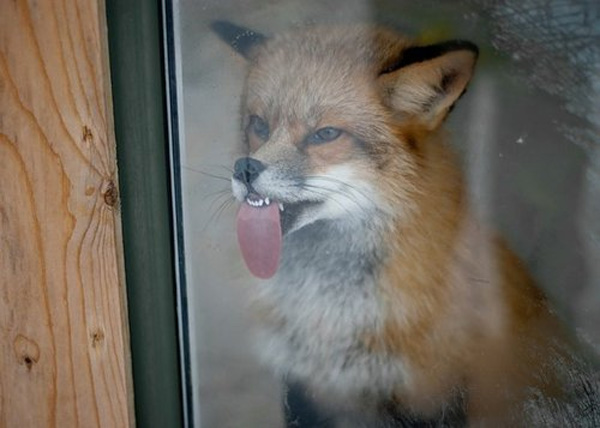





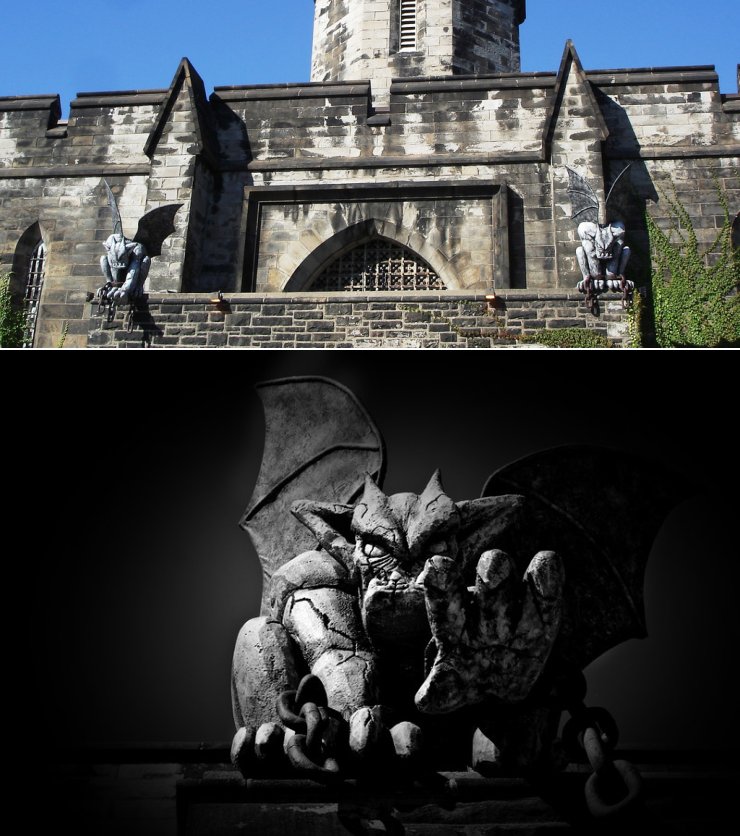
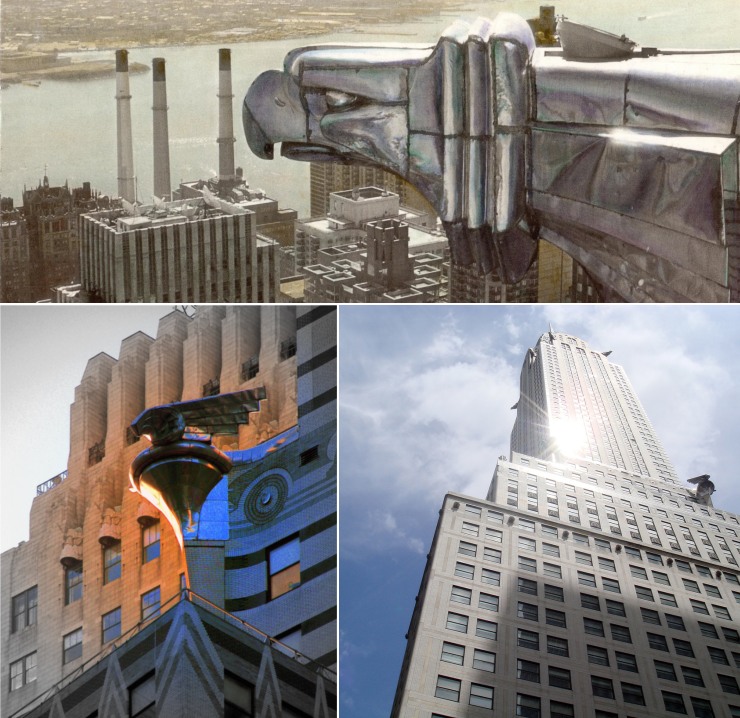


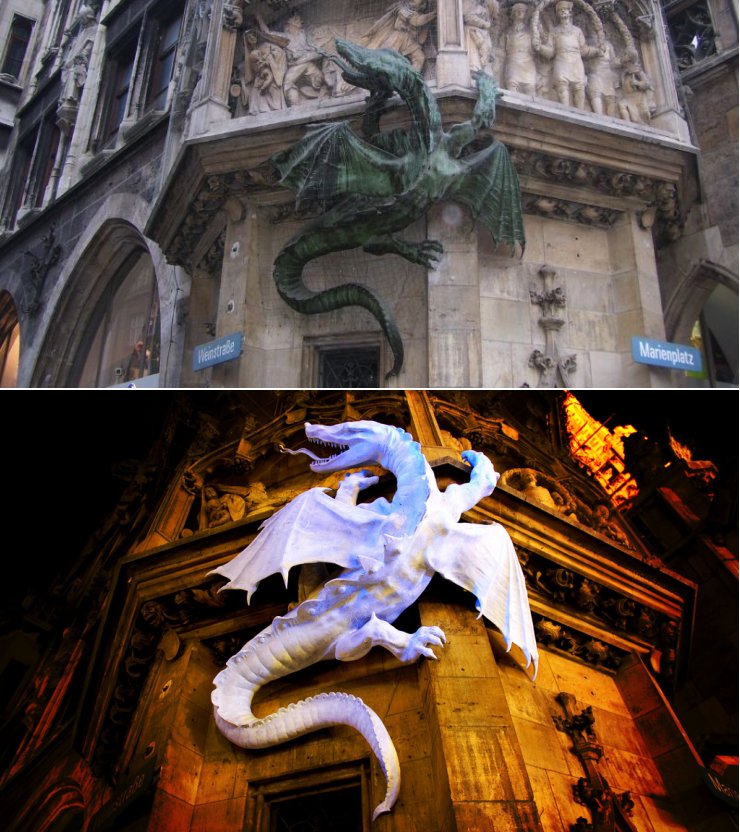
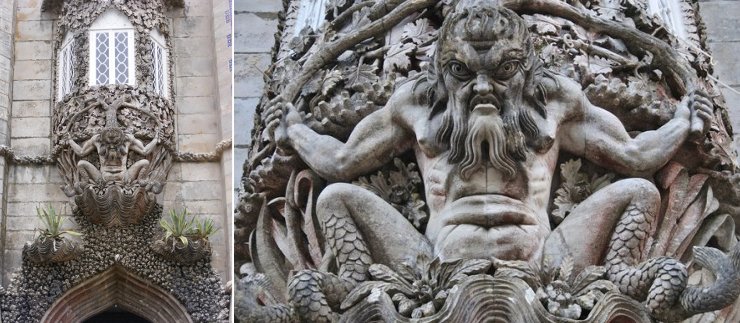
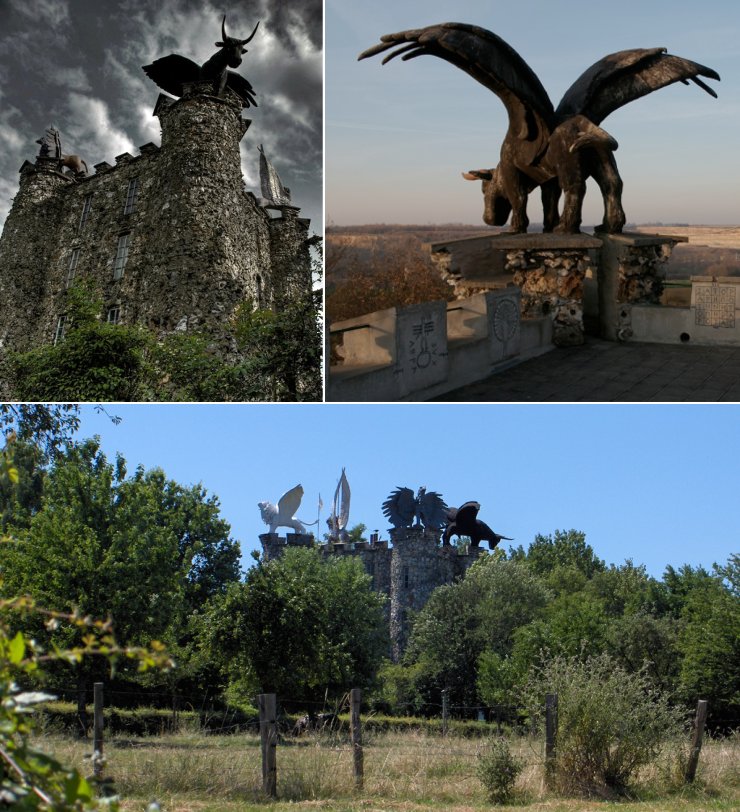
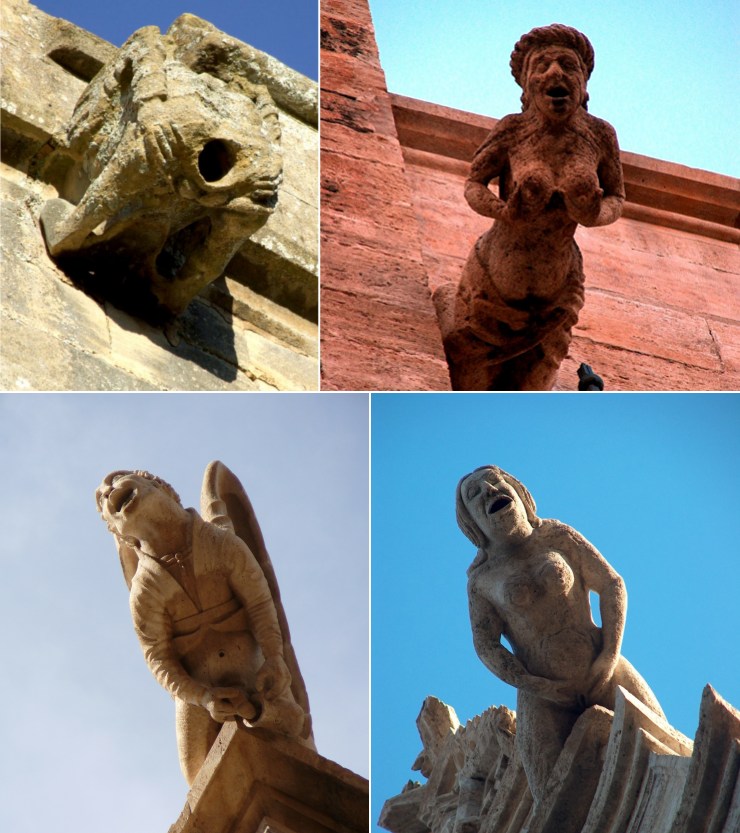










 Happy New Years Everybody!!!
Happy New Years Everybody!!!
